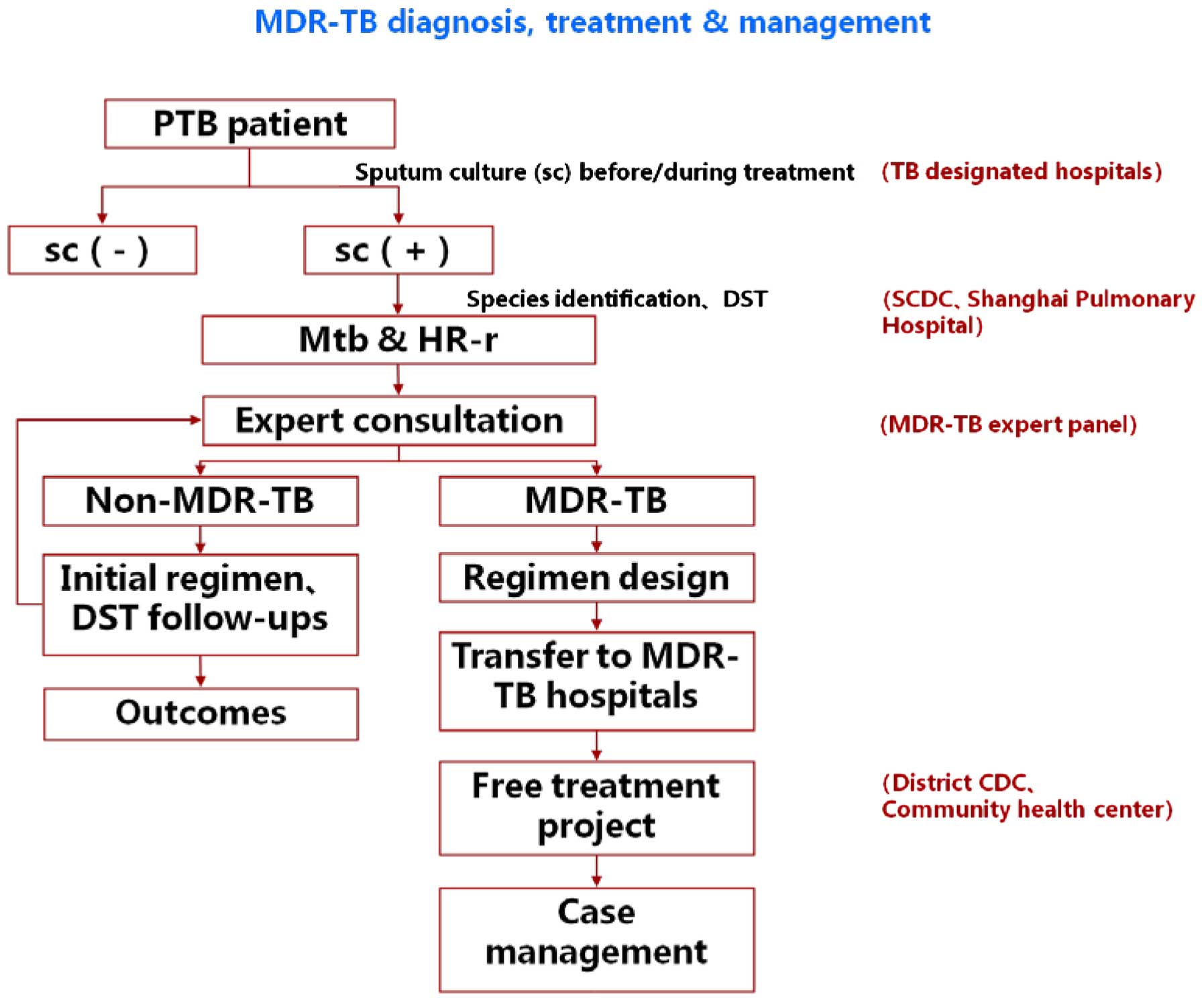|
1
|
World Health Organization (WHO):
Multidrug-resistant tuberculosis (MDR-TB): 2013 Update. WHO,
Geneva, Switzerland: 2013.
|
|
2
|
Laniado-Laborín R: Multidrug-resistant
tuberculosis: standardized or individualized treatment? The
question has already been answered. Expert Rev Respir Med.
4:143–146. 2010. View
Article : Google Scholar : PubMed/NCBI
|
|
3
|
World Health Organization (WHO):
Guidelines for the programmatic management of drug-resistant
tuberculosis - 2011 update. WHO (Geneva, Switzerland). 2011.
|
|
4
|
World Health Organization (WHO):
Definitions and reporting framework for tuberculosis - 2013
revision. WHO (Geneva, Switzerland). 2013.
|
|
5
|
World Health Organization (WHO): Global
tuberculosis report 2013. WHO (Geneva, Switzerland). 2013.
|
|
6
|
Bastos ML, Hussain H, Weyer K, et al:
Treatment outcomes of patients with multidrug-resistant and
extensively drug-resistant tuberculosis according to drug
susceptibility testing to first- and second-line drugs: an
individual patient data meta-analysis. Clin Infect Dis.
59:1364–1374. 2014. View Article : Google Scholar : PubMed/NCBI
|
|
7
|
World Health Organization (WHO): Global
tuberculosis control report 2011. WHO (Geneva, Switzerland).
2011.
|
|
8
|
Orenstein EW, Basu S, Shah NS, Andrews JR,
Friedland GH, Moll AP, Gandhi NR and Galvani AP: Treatment outcomes
among patients with multidrug-resistant tuberculosis: Systematic
review and meta-analysis. Lancet Infect Dis. 9:153–161. 2009.
View Article : Google Scholar : PubMed/NCBI
|
|
9
|
Mitnick CD, Franke MF, Rich ML, Viru
Alcantara FA, Appleton SC, Atwood SS, Bayona JN, Bonilla CA, Chalco
K, Fraser HS, et al: Aggressive regimens for multidrug-resistant
tuberculosis decrease all-cause mortality. PLoS One. 8:e586642013.
View Article : Google Scholar : PubMed/NCBI
|
|
10
|
Rodriguez M, Monedero I, Caminero JA, et
al: Successful management of multidrug-resistant tuberculosis under
programme conditions in the Dominican Republic. Int J Tuberc Lung
Dis. 17:520–525. 2013. View Article : Google Scholar : PubMed/NCBI
|
|
11
|
Kliiman K and Altraja A: Predictors of
poor treatment outcome in multi- and extensively drug-resistant
pulmonary TB. Eur Respir J. 33:1085–1094. 2009. View Article : Google Scholar : PubMed/NCBI
|
|
12
|
Liu CH, Li L, Chen Z, Wang Q, Hu YL, Zhu B
and Woo PC: Characteristics and treatment outcomes of patients with
MDR and XDR tuberculosis in a TB referral hospital in Beijing: a
13-year experience. PLoS One. 6:e193992011. View Article : Google Scholar : PubMed/NCBI
|
|
13
|
Jain K, Desai M, Solanki R and Dikshit RK:
Treatment outcome of standardized regimen in patients with
multidrug resistant tuberculosis. J Pharmacol Pharmacother.
5:145–149. 2014. View Article : Google Scholar : PubMed/NCBI
|
|
14
|
Marais E, Mlambo CK, Lewis JJ, Rastogi N,
Zozio T, Grobusch MP, Duse A, Victor T and Warren RW: Treatment
outcomes of multidrug-resistant tuberculosis patients in Gauteng,
South Africa. Infection. 42:405–413. 2014. View Article : Google Scholar : PubMed/NCBI
|
|
15
|
Brust JC, Gandhi NR, Carrara H, Osburn G
and Padayatchi N: High treatment failure and default rates for
patients with multidrug-resistant tuberculosis in KwaZulu-Natal,
South Africa, 2000–2003. Int J Tuberc Lung Dis. 14:413–419.
2010.PubMed/NCBI
|
|
16
|
Qazi F, Khan U, Khowaja S, Javaid M, Ahmed
A, Salahuddin N, Hussain H, Becerra MC, Golub JE and Khan AJ:
Predictors of delayed culture conversion in patients treated for
multidrug-resistant tuberculosis in Pakistan. Int J Tuberc Lung
Dis. 15:1556–1559, i. 2011. View Article : Google Scholar : PubMed/NCBI
|
|
17
|
Diacon AH, Pym A, Grobusch M, Patientia R,
Rustomjee R, Page-Shipp L, Pistorius C, Krause R, Bogoshi M,
Churchyard G, et al: The diarylquinoline TMC207 for
multidrug-resistant tuberculosis. N Engl J Med. 360:2397–2405.
2009. View Article : Google Scholar : PubMed/NCBI
|
|
18
|
Singla R, Sarin R, Khalid UK, Mathuria K,
Singla N, Jaiswal A, Puri MM, Visalakshi P and Behera D: Seven-year
DOTS-Plus pilot experience in India: results, constraints and
issues. Int J Tuberc Lung Dis. 13:976–981. 2009.PubMed/NCBI
|
|
19
|
Prasad R, Verma SK, Sahai S, Kumar S and
Jain A: Efficacy and safety of kanamycin, ethionamide, PAS and
cycloserine in multidrug-resistant pulmonary tuberculosis patients.
Indian J Chest Dis Allied Sci. 48:183–186. 2006.PubMed/NCBI
|
|
20
|
Kurbatova EV, Taylor A, Gammino VM, Bayona
J, Becerra M, Danilovitz M, Falzon D, Gelmanova I, Keshavjee S,
Leimane V, et al: Predictors of poor outcomes among patients
treated for multidrug-resistant tuberculosis at DOTS-plus projects.
Tuberculosis (Edinb). 92:397–403. 2012. View Article : Google Scholar : PubMed/NCBI
|
|
21
|
Falzon D, Gandhi N, Migliori GB, et al:
Collaborative Group for Meta-Analysis of Individual Patient Data in
MDR-TB: Resistance to fluoroquinolones and second-line injectable
drugs: impact on multidrug-resistant TB outcomes. Eur Respir J.
42:156–168. 2013. View Article : Google Scholar : PubMed/NCBI
|
|
22
|
Johnston JC, Shahidi NC, Sadatsafavi M and
Fitzgerald JM: Treatment outcomes of multidrug-resistant
tuberculosis: a systematic review and meta-analysis. PLoS One.
4:e69142009. View Article : Google Scholar : PubMed/NCBI
|
|
23
|
Cox HS, Kalon S, Allamuratova S, Sizaire
V, Tigay ZN, Rüsch-Gerdes S, Karimovich HA, Kebede Y and Mills C:
Multidrug-resistant tuberculosis treatment outcomes in
Karakalpakstan, Uzbekistan: treatment complexity and XDR-TB among
treatment failures. PLoS One. 2:e11262007. View Article : Google Scholar : PubMed/NCBI
|











